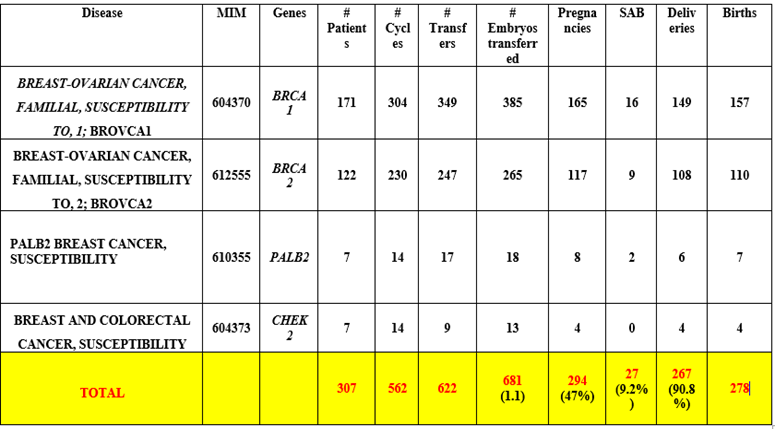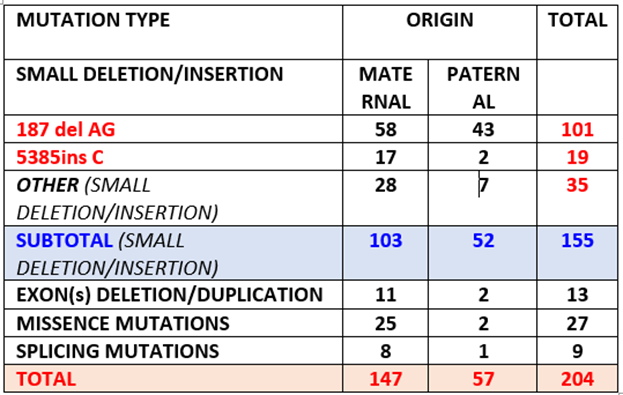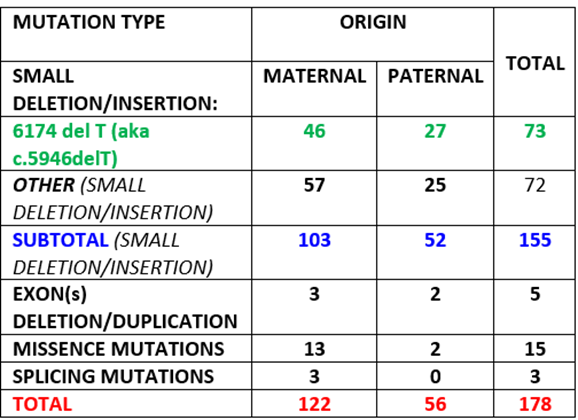AUCTORES
Globalize your Research
Research Article | DOI: https://doi.org/10.31579/2578-8965/172
Reproductive Genetic Innovations, Northbrook, IL.
*Corresponding Author: Anver Kuliev, Reproductive Genetic Innovations, Northbrook, IL.
Citation: Svetlana Rechitsky, Tatiana Pakhalchuk, Maria Prokhorovich, Agnes Machaj, Anver Kuliev, (2023), Expanding Application of Preimplantation Genetic Testing (PGT) for Breast Cancer, J. Obstetrics Gynecology and Reproductive Sciences, 7(4) DOI:10.31579/2578-8965/172
Copyright: © 2023, Anver Kuliev. This is an open-access article distributed under the terms of The Creative Commons Attribution License, which permits unrestricted use, distribution, and reproduction in any medium, provided the original author and source are credited.
Received: 18 May 2023 | Accepted: 29 May 2023 | Published: 09 June 2023
Keywords: preimplantation genetic testing for monogenic disorders (pgt-m)/ hereditary breast and ovarian cancer (hboc)/ predisposition to hboc/ expanded carrier screening (ecs)/ brca1/ brca2
Preimplantation genetic testing for monogenic disorders (PGT-M) has become an integral part of genetic practices, which is currently applied also to late-onset common disorders with genetic predisposition. Hereditary breast and ovarian cancers (HBOC) are the most frequent among these conditions, caused by mutations in BRCA1/2 genes. While available management strategies may not prevent HBOC in carriers of these genes, avoidance of inheritance of the predisposing genes to their offspring appeared an attractive approach, as PGT for BRCA1/2 genes allows selecting and transferring of embryos free of genetic predisposition to HBOC. The present paper describes the progress in application of PGT for HBOC, with its extended application also to carriers detected through expanded carrier screening (ECS). Presented data are based on our experience of 562 PGT-M cycles for HBOC, resulting in birth of 278 disease predisposition free children, representing one of the world’s largest series of PGT for HBOC, demonstrating an increasing importance of clinical implications of PGT-M as practical option for couples carrying BRCA1/2 predisposing genes.
Preimplantation genetic testing for monogenic disorders (PGT-M) was originally applied to avoid the recurrence risk of genetic disease in couples at risk, with its application initially restricted to severe monogenic conditions presented at birth. This was exactly as indications practiced in prenatal diagnosis, but applied for those at-risk couples who could not accept pregnancy termination, expected in 25–50% of cases depending on the mode of inheritance (1, 2). However, PGT-M indications have eventually been extended beyond those applied to prenatal diagnosis and currently include late-onset common conditions with genetic predisposition and even some correctable conditions, which have not initially been even justified for performing PGT (1, 2). Thus, the risk of having offspring with common late onset common conditions with a strong genetic predisposition is increasingly accepted as indication for PGT-M. The list of disorders for which PGT-M has now been applied comprises 750 different conditions, with the most frequent ones shifting to common conditions with genetic predisposition, such as cancer. As much as 10% of cancers can be attributed to hereditary syndromes, with 145 different genes suggested to have a role in causing cancer (3-5). Breast and ovarian cancer are the most frequent, representing 11% of all cancers and are also the most frequent indication for PGT-M, as will be described below. The available experience shows that the pathway of referral of hereditary breast and ovarian cancer (HBOC) to PGT-M has recently been changing with the current shift to direct referral through the information in social media, and lately through the application of expanded carrier screening (ECS), which identifies at risk couples who can benefit from PGT-M even without a known family history. Performed for the first time over twenty years ago (6), cancer predisposition has become one of the major indications for PGT-M, as it not only ensures avoiding inheritance of cancer predisposing genes, but also provides an opportunity to have an unaffected offspring of their own, despite having to undergo assisted reproductive technology (ART) (2, 7-10). It is also of note that BRCA 1/2 gene mutations causing predisposition to HBOC are mainly of autosomal-dominant mode of inheritance, with 50% risk of passing these genes to their offspring, so application of ECS programs allows detecting the at-risk individuals even before they themselves have contracted the disease, in addition to those diagnosed with HBOC and those with family history of HBOC (2, 11-17). We have previously reported our experience of PGT for HBOC, as part of our overall PGT-M experience (14), including a unique experience of PGT-M for HBOC combined with PGT-M for other additional conditions in at-risk couples (18). The present paper is an update of PGT for HBOC, presently applied also prospectively to an increasing number of at-risk couples detected through ECS, resulting in birth of 278 children free of cancer predisposing genes in one of the world’ largest series of PGT-M cycles performed for patients at risk of producing offspring predisposed to HBOC.
Material reported includes 512 PGT cycles for 307 patients at risk for HBOC caused by BRCA1 and BRCA2 mutations (Table 1), which is a part of our overall PGT-M experience of 10, 451 cycles. All PGT-M cycles were performed using a standard IVF protocol coupled with micromanipulation procedures of embryo biopsy, described elsewhere (19). The biopsied blastomeres or blastocyst samples were tested by the multiplex nested PCR analysis, involving the above mutations and linked marker analysis in a multiplex heminested system (2, 19). As more than half of the PGT-M cycles were from patients of advanced reproductive age, aneuploidy testing was also performed using next generation technologies (Illumina Inc) (NGS) for 24-chromosome aneuploidy testing. Pregnancy outcome was defined as the presence of a gestational sac with fetal cardiac activity. As per the informed consent, approved by Institutional Review Board, the embryos free of genetic predisposition to HBOC, based on the mutation and polymorphic marker information, were pre-selected for transfer back to patients, while those with predisposing mutant genes were considered affected, and tested to confirm the diagnosis.
Of 562 PGT cycles performed for HBOC, 681 embryos free of predisposing gene were detected for transfer in 622 cycles, resulting in 294 clinical pregnancies and birth of 278 children with no risk to develop breast cancer predisposed by these genes in their lifespan (Table 1).

The above is a part of our overall experience of 1,147 PGT-M cases for cancer, which is also a part of our overall PGT series of 10,451 PGT cases for PGT-M, with 2,517 resulting births, free of genetic disorder or genetic predisposition to common late-onset disorders.
As seen from Table 1, of 304 PGT cycles performed for BRSA1 mutations, 385 embryos free of predisposing gene were detected for transfer in 349 cycles, resulting in birth of 157 children with no risk to develop breast cancer predisposed by these genes in their lifespan. Of 230 PGT cycles performed for BRSA2 mutations, 265 embryos free of predisposing gene were detected for transfer in 247 cycles, resulting in birth of 110 children with no risk to develop breast cancer predisposed by these genes. Of 204 BRCA1 mutations tested, 147 were maternal and 57 paternal in origin, with the most prevalent being 187 del AG mutation (101 of 204 BRCA1 mutations, of which 58 were maternal and 43 paternal in origin) (Tabled 2).

The majority of 178 BRCA2 mutations were also of maternal origin (122 maternal and 56 paternal), the most prevalent being 6174 Del IT, 73 cases (46 maternal and 27 paternal)

Table 3). Overall, over two thirds (269 of 382) of BRCA1/2 mutations tested were of maternal origin. It is of note that according to our preliminary data (not presented here), the profile of BRCA1/2 mutations is gradually changing from most common to unique mutations, with more than half in BRCA1, and almost two thirds in BRCA2, probably with introduction and the application of PGT-M for at risk couples ascertained through ECS.
Thus, among the patients presenting for PGT-M were not only those diagnosed with HBOC, but also patients presenting for fertility preservation, as well as those with information of such conditions in their extended families, with the most recent addition of carriers of BRCA1/2 gene mutations detected through ECS (20-25). Without prospective detection of the carriers of predisposing genes to HBOC, more than half of the patients who may develop cancer due to inherited predisposition may be missed with major implications for family members. The presented experience demonstrates considerable progress in using PGT for avoiding the birth of children with genetic predisposition to HBOC. As mentioned, inherited cancer predisposition is presently one of the major conditions for which PGT is being performed, providing an option for couplers at risk to avoid the birth of an offspring with predisposition to HBOC.